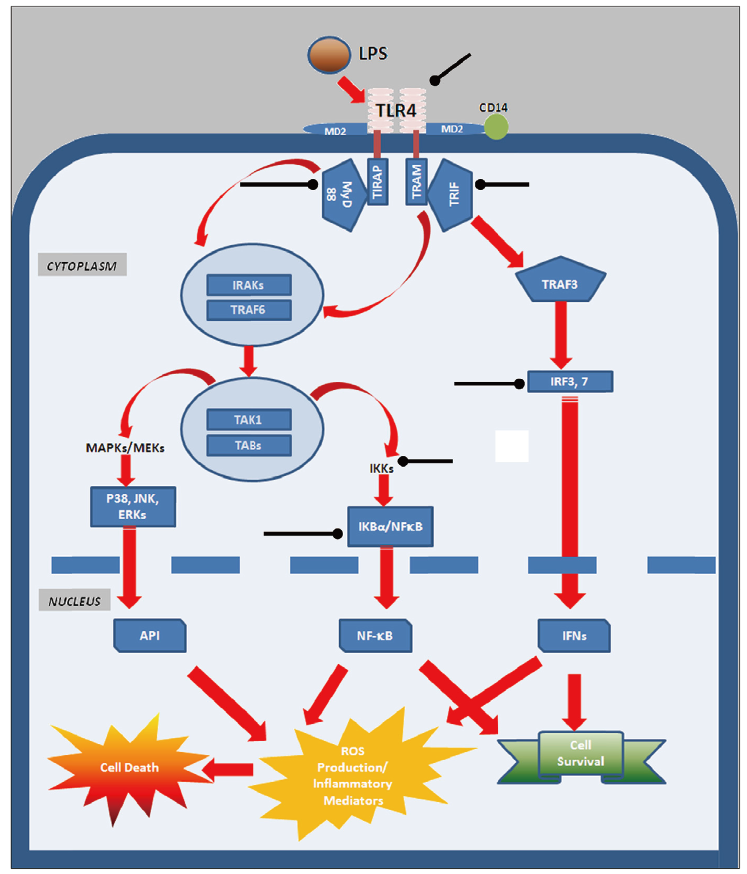
Our promise to you:
Guaranteed product quality, expert customer support.
 24x7 CUSTOMER SERVICE
24x7 CUSTOMER SERVICE
 CONTACT US TO ORDER
CONTACT US TO ORDER
TLR4 Gene Editing 
Toll-like receptors (TLRs) mainly known for the pathogen recognition and subsequent immune responses are being investigated for their pathogenic role in diverse chronic diseases. Toll-Like Receptor 4 (TLR4) is the member of TLR family that recognizes and is activated via bacterial lipopolysaccharide (LPS), which is the main molecular component of the cell wall of Gram-negative bacteria. As other TLRs, TLR4 has a modular structure composed by a domain constituted by leucine-rich repeats (LRR) in the extracellular part, connected to an intracellular TIR domain responsible for the signal transmission. Molecular recognition of minute amounts of circulating LPS by the TLR4 receptor system, followed by receptor dimerization on the cell membrane, starts the cascade of protein-protein interactions resulting in the production of pro-inflammatory cytokines and interferons, thereby launching the inflammatory and immune responses.
TLR4 Signaling Pathways
TLRs can be activated by multiple types of stimuli. These could be categorized as pathogens, different cytokines or even stress that is induced in the cells. These stressors can be mainly induced by disease, engaging neural cells. These outcomes are followed by tissue injury. The main pathway activated by LPS is the myeloid differentiation primary response protein 88 (MyD88) dependent and independent pathways. The common step to both pathways is the recognition of the lipid A-region of LPS by TLR4. LPS binds to LPS binding protein (LBP) and the resulting complex attaches to another protein described as cluster of differentiation 14 (CD14). It has been suggested that the main role of CD14 is to enhance TLR4 signaling by facilitating its transport to lipid rafts in the cellular membrane. Subsequently, the co-receptor myeloid differentiation factor-2 (MD-2) is recruited to promote the translocation of TLR4 to the cell membrane. This essential process is followed by endocytosis of the TLR4/MD2 complex. The recognition of the heterotrimer CD14/TLR4/MD-2 to LPS induces the activation of the MyD88 dependent and independent pathways. Signaling pathways by TLR4 activate various transcription factors like activator protein 1 (AP1), Nuclear factor kappa-light-chain-enhancer (NF-κB), Signal Transducers and Activators of Transcription family of transcription factors (STAT1) and Interferon regulatory factors (IRFs), which are the key players regulating the inflammatory response. Inhibition of these targets and their upstream signaling molecules provide a potential therapeutic method to treat inflammatory diseases.
 Figure 1. TLR4 signaling pathway. (Rahimifard M, et al. Ageing research reviews)
Figure 1. TLR4 signaling pathway. (Rahimifard M, et al. Ageing research reviews)
TLR4 and Disease Therapy
The physiological role of TLR4 has been proposed in diseases such as rheumatoid arthritis, atherosclerosis, allergy, neuropathic pain, hemorrhagic shock, ischemia/reperfusion injury, alcohol-induced neuroinflammation and diabetes. Besides, TLR4 has therapeutic importance because of its role in severe sepsis associated with Gram-negative bacterial infection, inflammation, autoimmune diseases, and posttraumatic disorders. It recognizes the bacterial endotoxin LPS, which is released from bacteria due to cell wall repair, biosynthesis, or death. The University of Pittsburgh has developed several TLR4 antagonists (referred to as T4ICs) based on the compounds isopropyl 3,4,6-tri-O-acetyl-2-(acetylamino)-2-deoxyhexopyranoside, 2-(acetylamino)-2-deoxy-4-O-hexopyranosylhexopyranose, and 2-(acetylamino)-2-deoxy-D-galactopyranose hydrate. These molecules were found to reduce NFκB activation and cytokine production during infections and inflammatory disorders. Stilbene glycoside is a plant-derived natural compound that has shown antiangiogenic, antioxidant, and antimalarial properties in experimental settings. Recently, a novel stilbene glycoside was found to effectively reduce TLR4-mediated NFκB activation to a greater extent and to inhibit inflammatory cytokine release.
Accumulating evidence shows that TLR4 can directly recognize opioid ligands, and trigger neuroinflammatory response. Thus, blocking the TLR4-MD2 complex using inhibitor/antagonists would be beneficial in treating morphine-induced proinflammation. A series of small molecule inhibitors of the TLR4/MD-2 complex (compound 1 and its analog) have been designed by structure-activity relationship (SAR) studies that potentiate morphine analgesia via blocking opiate-induced TLR4 activation. Besides, the recognition that opioid antagonists function as TLR4 antagonists indicates that targeting TLR4 to treat neuropathic pain may be effective.
TLR4 Gene Editing Service
CRISPR/Cas9 PlatformCB, a global leading biotechnological company specializing in gene editing, is dedicated to offering comprehensive CRISPR/Cas9 gene editing services and products for academic research, biotech research and pharmaceutical drug discovery. With deep gene editing knowledge and extensive experience in experimental operation and data processing, we help you effectively control TLR4 genes knockout/knockin/point mutation in cells or animals via CRISPR/Cas9 technology.
| Service | Details | Alternative cell lines or animal species |
| TLR4 Gene Editing Cell Line Generation |
| HEK239T, Hela, HepG2, U87, Ba/F3, CHO, MDA-MB-453, MDA-MB-231NIH3T3, T47D, Neuro2a, MCF7, RKO, K562, RAW264.7, etc. |
| TLR4 Gene Editing Animal Model Generation |
| Mouse, rat, rabbit, zebrafish, C. elegans, etc. |
Related Products at CRISPR/Cas9 PlatformCB
| CATALOG NO. | PRODUCT NAME | PRODUCT TYPE | INQUIRY |
| CCKM0541 | BALB/c-Tlr4em1Cd | Knockout Mice | Inquiry |
| CCKM0880 | B6J-Tlr4em1Cd | Knockout Mice | Inquiry |
| CDKM-0666 | B6J-Tlr4em1Cflox | Knockout Mice | Inquiry |
References
- Patra M C, Choi S. Recent progress in the development of Toll-like receptor (TLR) antagonists. Expert opinion on therapeutic patents, 2016, 26(6): 719-730.
- Manček‐Keber M, Jerala R. Postulates for validating TLR4 agonists. European journal of immunology, 2015, 45(2): 356-370.
- Kuzmich N N, et al. TLR4 signaling pathway modulators as potential therapeutics in inflammation and sepsis. Vaccines, 2017, 5(4): 34.
- Rahimifard M, et al. Targeting the TLR4 signaling pathway by polyphenols: a novel therapeutic strategy for neuroinflammation. Ageing research reviews, 2017, 36: 11-19.
- Roy A, et al. Potential therapeutic targets for inflammation in toll-like receptor 4 (TLR4)-mediated signaling pathways. International immunopharmacology, 2016, 40: 79-89.
- Jia S J, et al. TLR4 signaling: A potential therapeutic target in ischemic coronary artery disease. International immunopharmacology, 2014, 23(1): 54-59.